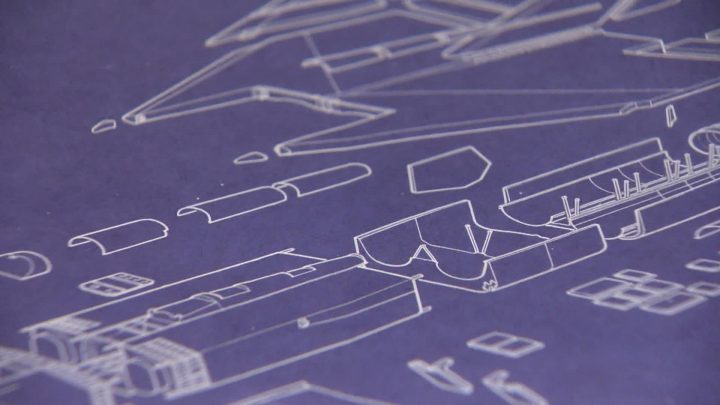All material associated with the Avro Arrow were ordered destroyed by the Canadian government when the project was cancelled in 1959.

Ken Barnes ignored the order — he kept a set of the original blueprints he had drafted.
Those blueprints are now on display at the Diefenbaker Canada Centre in Saskatoon as part of an exhibit telling the story of the Arrow.
“He kept it in his basement for years, just tucked away,” said Helanna Gessner, curatorial collections and exhibits manager at the centre.
Gessner said she became aware of the blueprints when the centre put out a call for artifacts for the exhibit.
“We were put in contact with Gord Barnes. His father, Ken, was a senior draftsman for Avro Canada,” Gessner explained.
“There’s 300 blueprints in total that Ken had drawn.”
The Arrow was meant to be the first fighter jet designed, built and operational in Canada.
It was axed by then-prime minister John Diefenbaker in 1959 during its testing phase due to escalating costs.

Get daily National news
Diefenbaker’s government said it was a cost-cutting measure as the program was taking up to 25 per cent of the Air Force’s annual budget.
“The budget was just going way too high to maintain the Arrow the way it was and continue to fund everything else with the defence budget,” Gessner explained.
“While it really negatively impacted people directly in the east who (were) working there, as they moved further west, people’s feelings changed and they were like ‘great, we’re cutting spending.’”

Interest in the Avro Arrow was renewed in 2017 when the “Raise the Arrow” project launched.
“There was about six models that were rocket launched to test the wing design, the Delta wing design. And they were just at the bottom of (Lake Ontario),” Gessner said.
“They’ve actually found one already. They pulled it out of Lake Ontario and are trying to figure out how to conserve it now.”
Gessner said the 50th anniversary of the moon landing in 2019 also renewed interest in the Arrow.
A large team from the scrapped Arrow project joined NASA at the start of its manned space program.
Avro’s chief of technical design, Jim Chamberlin, went on to become the chief designer of the Gemini spacecraft.
Owen Maynard, a designer on the Arrow project, went on to play a key role in the Apollo program that helped land man on the moon.
Gessner said although the cancellation of the Arrow program reflects negatively on Diefenbaker, it is important to the centre to show all sides of history.
“Even if something shows Diefenbaker in not the best light, because he really was vilified for single-handedly cancelling the Arrow, showing that side of his history is really important,” Gessner said.
“It had a lot of national pride in Canada… it’s something that people are always interested in.”
Reaction to the display has been mixed, Gessner said, with some happy and others upset it is on display at the centre.
“We thought this was a really good platform to try to share a little bit more that we are trying to be as non-partisan as possible and show different sides of history.”

And keeping the history of the Arrow alive is important for Gessner.
“The impact that the Arrow itself had on the aviation industry for Canada, was amazing,” she said.
“So many people worked at Avro Canada or worked for the companies that supplied them and people really rallied around their designs.”
There is also a pop-culture component to the Arrow.
“They made little Jell-O wheels, so when you opened up the packs that kids would collect them,” Gessner said, adding it also extended into trading cards, models and stamps which are all on display.
“People are really surprised that this much history and artifacts have survived.”







Comments